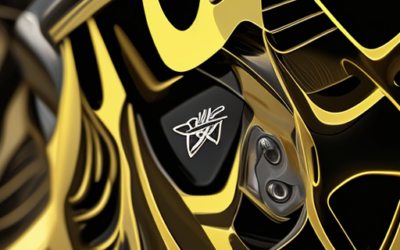Modern Wheel Designs: The Future of Transportation?

1. Introduction
The future of transportation is constantly evolving, with new technologies and designs being developed every day. One area that has seen significant advancements in recent years is wheel design. From lightweight materials to energy efficient technologies, modern wheels are pushing the boundaries of what is possible when it comes to transportation. In this article, we will explore some of the latest developments in wheel design and consider whether they may hold the key to the future of transportation.

2. Lightweight Materials
Lightweight materials have become increasingly important in modern wheel design as they can significantly reduce the overall weight of a vehicle. This not only improves fuel efficiency and reduces emissions, but it also enhances the performance and handling of the vehicle. Additionally, lightweight materials can help to improve safety by reducing the risk of injury in the event of a collision. Some examples of lightweight materials used in modern wheel designs include aluminum, magnesium, and carbon fiber composites. These materials offer high strength-to-weight ratios, making them ideal for use in wheels where every gram counts. Furthermore, advancements in manufacturing techniques have made it possible to produce complex shapes and structures using these lightweight materials, leading to innovative and stylish wheel designs.

3. Energy Efficient Technologies
Energy efficiency is a crucial aspect of modern wheel design as it helps reduce fuel consumption and carbon emissions. Several technologies have been developed to improve the energy efficiency of vehicles with wheels. These include:
1. Regenerative Braking Systems: This technology captures kinetic energy that would otherwise be lost during braking and converts it into electricity to power the vehicle’s battery. This reduces the need for fossil fuels and decreases the amount of carbon dioxide emitted into the atmosphere.
2. Start-Stop Systems: These systems automatically turn off the engine when the vehicle comes to a stop, such as at a traffic light or in heavy traffic. When the driver releases the brake pedal, the engine quickly restarts, providing a smooth and seamless transition.
3. Hybrid Powertrains: These systems combine a traditional internal combustion engine with an electric motor, allowing the vehicle to switch between the two depending on the driving conditions. This results in improved fuel efficiency and reduced emissions.
4. Turbocharged Engines: By compressing air before it enters the engine, turbocharging increases the engine’s efficiency, allowing it to burn fuel more effectively. This leads to improved performance and better fuel economy.
5. Fuel Cell Technology: This technology uses hydrogen fuel cells to generate electricity, producing water vapor as a byproduct. It offers a clean and efficient alternative to traditional gasoline engines, with potential for zero emissions.

4. Self-Driving Vehicles
Self-driving vehicles are becoming increasingly popular as technology advances and people become more interested in convenience and efficiency. These cars use advanced sensors and software to navigate roads without human intervention, making them safer and more efficient than traditional vehicles. They can also reduce traffic congestion and improve overall transportation infrastructure. However, there are still concerns about job displacement and privacy issues that need to be addressed before widespread adoption.

5. Electric Powertrains
Electric powertrains have become increasingly popular in recent years as more and more people look for ways to reduce their carbon footprint and move towards sustainable transportation options. These powertrains offer several advantages over traditional gasoline or diesel engines, including lower emissions, quieter operation, and improved performance.
One of the key benefits of electric powertrains is that they can provide instant torque, which means that vehicles equipped with them can accelerate quickly and smoothly. This makes them well-suited for urban driving, where quick bursts of speed are often necessary to navigate busy streets and intersections.
Another advantage of electric powertrains is that they require much less maintenance than traditional engines. Since there are fewer moving parts and no need for oil changes or spark plugs, electric vehicles can save owners significant amounts of time and money in the long run.
However, one of the main challenges facing electric powertrains is range anxiety – the fear of running out of power while on the road. While battery technology has come a long way in recent years, it still has some limitations when it comes to range and charging times. As a result, many electric vehicle owners must plan their trips carefully to ensure that they have enough charge to reach their destination.
Despite these challenges, electric powertrains are poised to play a major role in the future of transportation. With advances in battery technology and charging infrastructure, it’s likely that we’ll see even greater ranges and faster charging times in the coming years. Additionally, the development of autonomous vehicle technologies could further increase the appeal of electric powertrains, as self-driving cars would be able to operate without the need for a human driver to monitor the battery level.

6. Advanced Safety Features
Advanced safety features have always been a priority in the development of modern transportation systems. With the integration of cutting-edge technologies, vehicles equipped with advanced safety features can detect potential hazards and respond proactively to prevent accidents from occurring. Some examples of these features include lane departure warning systems, blind spot detection, forward collision warning, automatic emergency braking, and adaptive cruise control. These features not only enhance driver confidence but also contribute to improved road safety, reducing the number of accidents on our roads. As technology continues to advance, we can expect even more sophisticated safety features to become available, further enhancing the driving experience and ensuring a safer journey for all.

7. Connectivity and Mobility Solutions
The future of transportation is not just about the technology used in vehicles, but also about how people interact with them. Connectivity and mobility solutions play a crucial role in shaping the way we move around our cities and towns. With advancements in technology, it is now possible to have seamless connectivity between different modes of transportation, making it easier and more convenient for people to get around.
One of the most exciting developments in this area is the integration of smartphone apps into the transportation experience. These apps allow users to plan their routes, track their vehicles, and even pay for rides all from their phone. This level of convenience has the potential to revolutionize the way we think about transportation, making it more accessible and efficient than ever before.
Another important aspect of connectivity and mobility solutions is the use of shared mobility services. These services allow people to share cars, bikes, or scooters, reducing the number of individual vehicles on the road and cutting down on emissions. By leveraging technology, these services can be easily accessed through mobile apps, making it easy for people to find and use alternative forms of transportation.
In addition to these technological advancements, there is also a growing focus on creating more pedestrian-friendly cities. This includes designing streets and sidewalks that prioritize safety and accessibility, as well as implementing programs to encourage walking and biking. By making it easier and safer for people to walk and bike, cities can reduce traffic congestion and improve air quality.
Overall, connectivity and mobility solutions have the potential to transform the way we move around our cities and towns. By leveraging technology and design, we can create a more sustainable, convenient, and enjoyable transportation experience for everyone.

8. Innovative Designs and Styles
As technology continues to advance, so too does the design and style of modern wheels. From sleek and aerodynamic shapes to bold and futuristic styles, there is a wide range of innovative designs and styles available in the market today. These unique designs not only improve the appearance of vehicles, but they can also enhance performance and reduce drag. Some of the most popular innovative wheel designs include:
* Spoke wheels: These wheels feature spokes that radiate from the center hub, giving the wheel a distinctive and eye-catching look. Spoke wheels are often used on high-performance sports cars and motorcycles.
* Split wheels: Also known as bicycle wheels, split wheels have a center section that is separated into two halves. This design allows for greater flexibility and durability, making it ideal for off-road and adventure vehicles.
* Concave wheels: Concave wheels have a curved profile, with the outer rim of the wheel appearing to bow outwards. This design is often used on luxury vehicles and can give them a sleek and aggressive appearance.
* Wire wheels: Wire wheels feature a latticework of thin wires instead of traditional spokes. This design reduces weight and improves strength, making it ideal for high-performance vehicles.
* Carbon fiber wheels: Carbon fiber wheels are made from a lightweight and strong material that is increasingly being used in the automotive industry. These wheels offer excellent performance and can reduce overall vehicle weight.
In conclusion, innovative designs and styles are an important aspect of modern wheel technology. By pushing the boundaries of design, manufacturers are able to create wheels that not only look great, but also perform optimally and reduce drag. As the demand for sustainable and efficient transportation solutions continues to grow, we can expect to see even more innovative designs and styles emerge in the future.

9. Sustainable Manufacturing Practices
Sustainable manufacturing practices are becoming increasingly important in the automotive industry as consumers demand more environmentally friendly products. Many modern wheel designs incorporate sustainable materials and production methods to reduce their carbon footprint and promote a greener future. For example, some wheels are made from recycled materials such as aluminum or plastic, which require less energy to produce compared to traditional materials like steel. Additionally, many manufacturers are adopting eco-friendly production processes, such as using renewable energy sources or reducing waste during the manufacturing process. These efforts not only benefit the environment but also help companies save money and resources in the long run. As sustainability continues to be a top priority for consumers, it is likely that we will see even more innovative sustainable manufacturing practices in the future of transportation.

10. Conclusion
In conclusion, modern wheel designs have come a long way in recent years, with advancements in technology and materials leading to more efficient, sustainable, and safe transportation options. As we continue to push the boundaries of innovation, it’s clear that these new wheel designs have the potential to revolutionize the future of transportation. Whether through self-driving vehicles, electric powertrains, or advanced safety features, the possibilities are endless. However, it’s important to remember that progress must be balanced with responsibility, as we work towards creating a better, more sustainable world for generations to come. With continued research and development, the future of transportation looks bright, and we can’t wait to see what the next generation of wheels has in store.



